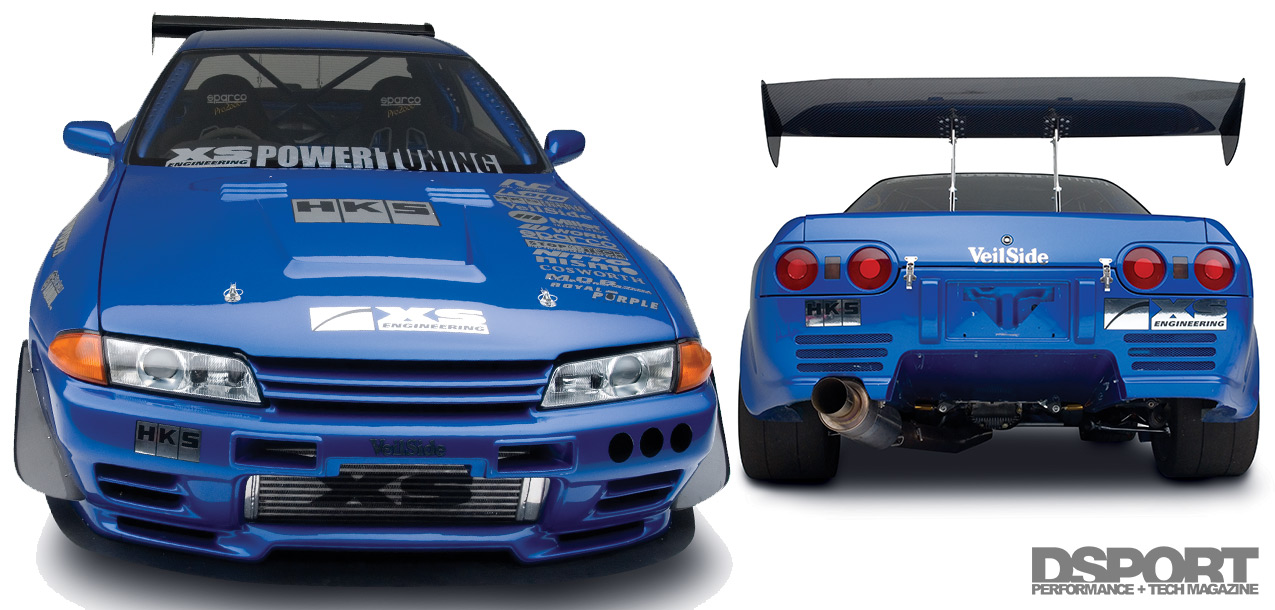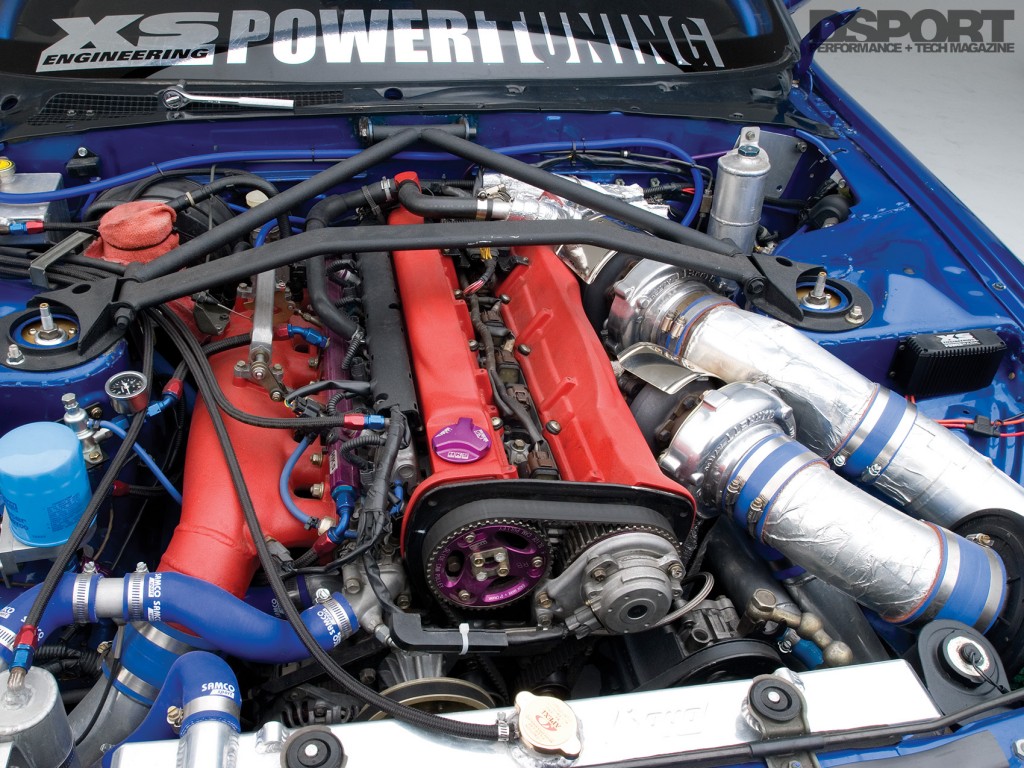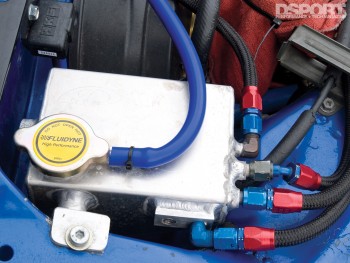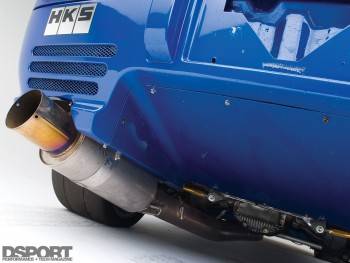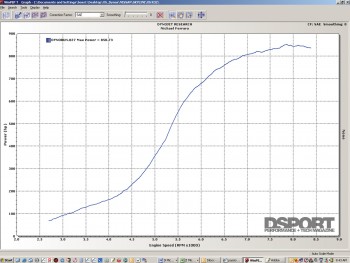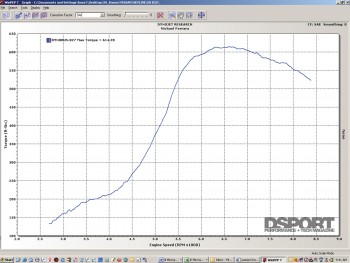Deception
A 2.8-liter RB26DETT engine looks the same as a 2.6-liter RB26DETT engine from the outside. By using a little deception, XS Engineering would effectively increase the displacement of the RB engine. To achieve this end, XS Engineering chose a HKS Step-2 Stroker Kit. HKS’ stroker kit increases the engine’s displacement by enlarging the cylinder-bore size and increasing the stroke. HKS 87mm forged-aluminum pistons add a millimeter to the cylinders’ bore. The pistons are forged from high- grade 4032 aluminum. To assist in broadening the engine’s torque curve, HKS’ Step-2 kit uses a 77.7mm crankshaft. The forged- steel crank adds 4mm to the stroke of the RB. The crank makes its connection to the pistons by a row of six HKS 4340 H-Beam connecting rods. Upgraded factory-size 21mm wrist pins secure the forged- aluminum pistons to the rods. HKS Japan balances the rotating assembly, ensuring the increase in vibration is minimal during the increase of engine speed.
On the top end, XS’ technicians massage the RB26 head with their acclaimed Race Porting and Polishing service. This procedure opens the intake and exhaust ports allowing the maximum volume of airflow. Regulating the ingested air-fuel mixture, HKS custom camshafts and Duraluminum cam sprockets control the opening and closing events of the valves. When using high-lift, long- duration HKS camshafts, upgrading the valvetrain is necessary. HKS Step-3 springs, retainers and guides inhibit valve float while the valves are wide open. With a HKS 1.2mm metal head gasket in place, ARP head bolts cinch the cylinder head to the block.
Taking command, an HKS F-Con V-Pro engine-management system offers unsurpassed control for the R32. When tuned in with the correct values for the fuel and ignition timing maps, the F-Con V-Pro delivers optimum performance. Matching HKS’ EVC boost controller to the F-Con, manifold-absolute pressure is also kept in check. Igniting the air-fuel mixture is imperative to generating the maximum power. To this end, XS Engineering’s Power-Pack ignition amplifier magnifies the voltage to a set of HKS Super-Iridium Racing spark plugs.
XS’ GT-R features a race-ready fuel system to keep the R32 within regulation for race duty. Starting at the ATL fuel cell, an external Aeromotive fuel pump pulls VP Racing Fuel’s C16. Flowing forward, an SX Performance fuel filter holds back any debris from the fuel before it reaches the HKS Fuel Pressure Regulator. The FPR adjusts fuel pressure being distributed by an HKS Fuel Rail. A set of six RC Engineering 1000cc/min fuel injectors spray the fuel into the cylinder head. At this point, fuel is atomized with air that is brought in by the factory-RB26 intake manifold and individual throttle bodies.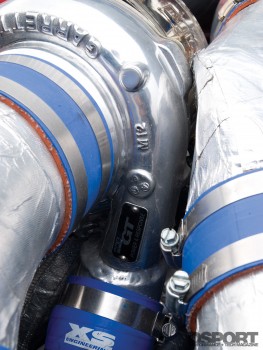
Bringing in a surplus of fuel is not in vain as an HKS GT2835R Full- Turbine Upgrade produces the complementing airflow. An HKS Tubular exhaust manifold plants the foundation for the twin-turbo system. HKS’ stainless-steel manifold positions two HKS GT2835R turbochargers. Carrying wasted gas from the outlet of the turbos are two custom downpipes by XS Engineering. The downpipes meet an HKS exhaust system that features a 102mm diameter. Two HKS Racing wastegates regulate boost pressure. Directing charged-air from the turbos, HKS intercooler piping routes airflow to an XS Engineering Power I/C. XS’ Power I/C uses a tube-and-fin design to dissipate heat before charged-air makes its way into the engine.
The combination of power- producing components transitions this R32 into being a time-attack monster. To measure the performance gain of this buildup, XS depends on its Dynamic Test Systems AWD and DynoJet chassis dynamometers. As boost pressure is set to 2.0kg/cm^2 (28.4 psi), the DynoJet relays a striking 850 horsepower at the wheels at 7,850 RPM and 614 lb/ft of torque at 6,600 RPM.


